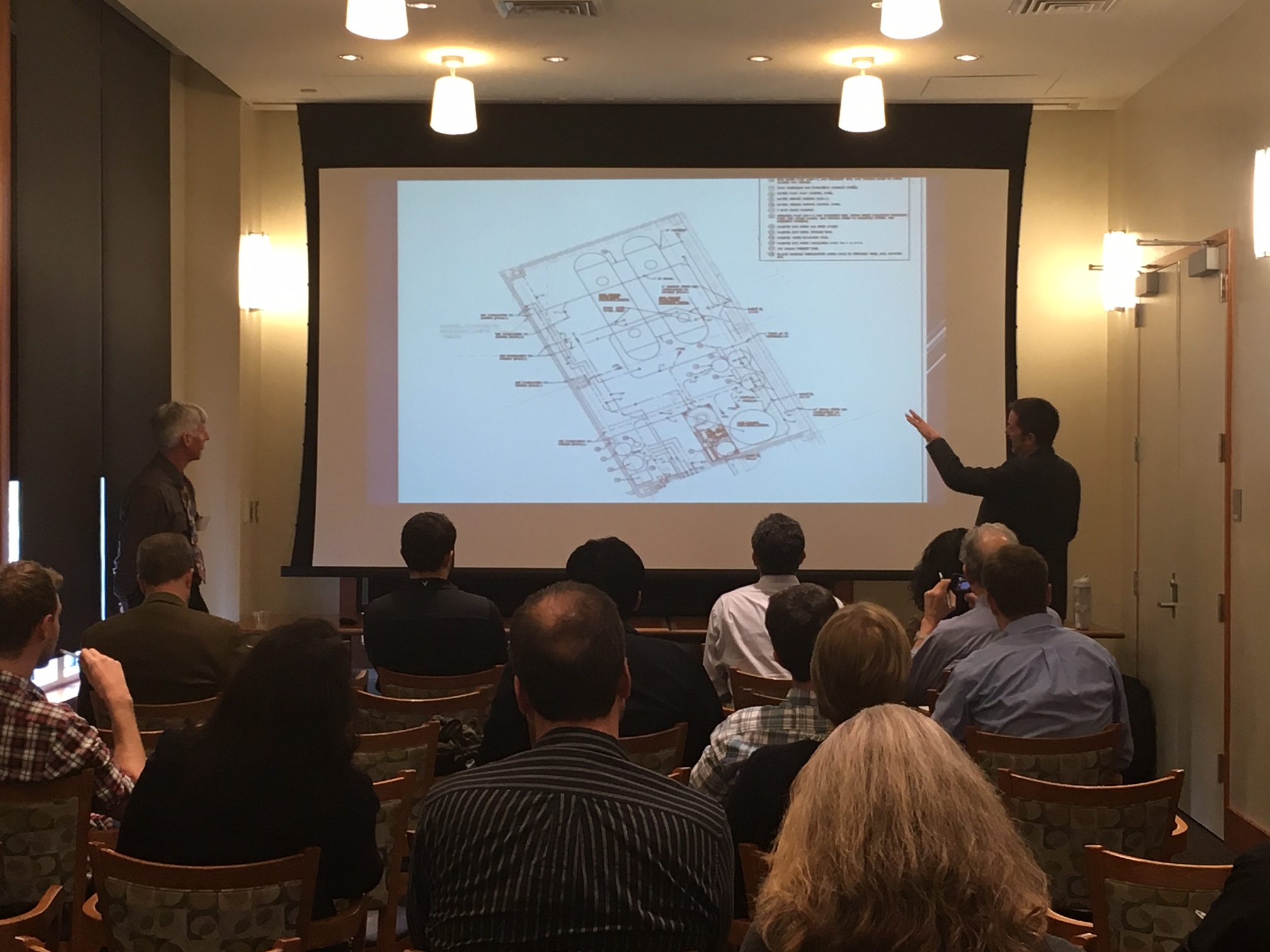
Last week, Tanks Direct had the opportunity to host a session at U.S. Green Building Council’s Engineering Green Conference in Baltimore, Maryland. Tanks Direct is at the forefront of the rainwater harvesting conversation and we were grateful for the opportunity to educate attendees about water reclamation design concepts.
Rainwater catchment is becoming a common request in the scope of work for construction projects – especially since stormwater management is becoming a critical requirement in urban areas. Our presentation touched on the many misconceptions about rainwater harvesting tanks. The most common question we receive is in regard to properly sizing a rainwater tank (cistern). Tanks Direct can help you size your rainwater harvesting tanks to ensure that they conform to the LEED/Green concept of the “triple bottom line.” This means the design takes into account social concerns, environmental concerns, and financial concerns.
There tends to be a “give and take” when it comes to properly size a rainwater tank.
When sizing a rainwater tank, you want to ensure that your facility is optimizing the size of the tank with the amount of water available (rain totals) and the amount of water you are going to reuse. Another consideration is local regulations and requirements. If the tank is too big, you will be able to catch a lot of water, but the upfront cost outweighs the benefit of the additional water available. If the tank is too small, you will have a smaller initial economic impact, but you will also have many periods throughout the year where the system will be running on makeup water (not rainwater) or overflowing usable water. Neither of these examples is cost-effective or sustainable. Below, we feature some important factors to consider when sizing your tank.
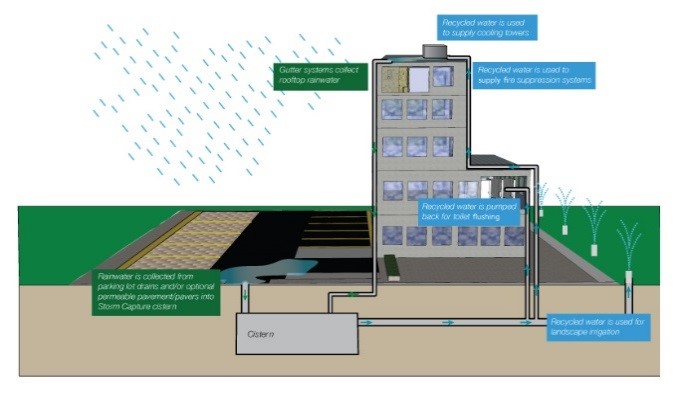
Rainfall Calculations and Potential Water Collection
It may seem obvious, but the first thing to consider when sizing your tank is how much water is available for reuse. There are two driving factors for this variable – historical rainfall and available roof space. The typical equation looks at monthly and annual rainfall totals for a specific location. These equations can be found on various government websites or are already incorporated into publicly available spreadsheets. The other piece of the puzzle is the total square footage of the facility that is catching the rainfall and directing it to the cistern. Rainfall totals and square footage determine how much water is potentially available per month As discussed, spreadsheets are available to help you make this determination. For example, the Department of Energy & Environment in Washington, DC, has a Rainwater Calculator to assist those interested in calculating their potential rainwater retention. Here is a link to this spreadsheet:
http://ddoe.dc.gov/swguidebook
Search the attachments for a document called the 2013 Rainwater Harvesting Retention Calculator
An experienced engineer can also assist you with these calculations.
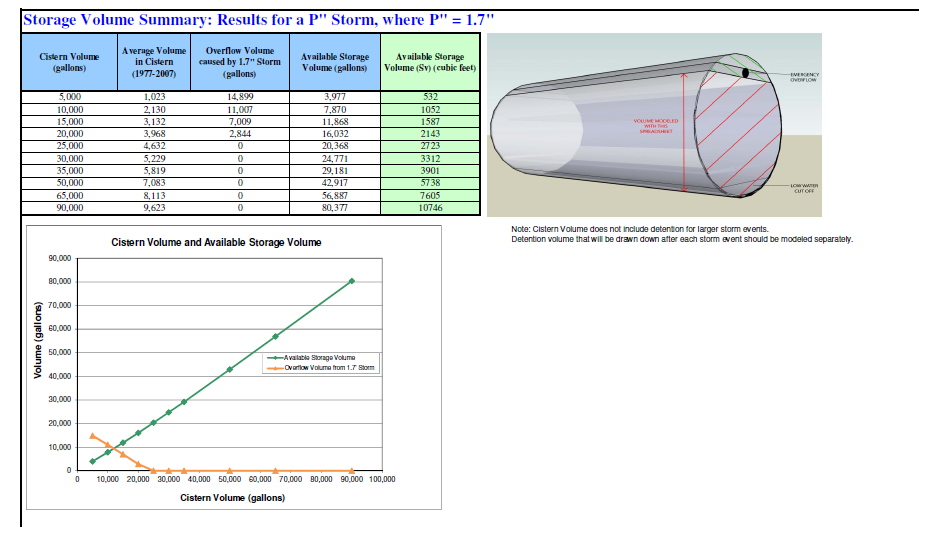
Water Usage Determination
Capturing rainwater water is important, but if you don’t have reuse options there is no need to capture the water. The next step of the process is figuring out how much water can be reused. Common reuse applications are toilet flushing, irrigation, cooling tower makeup, and laundry. Many of the spreadsheets have cells where the reuse options can be plugged in. This will help you figure out how much water you can reuse per day. Once all of this data is calculated, you will be presented with a range of potential tank sizes that will meet your reuse needs.
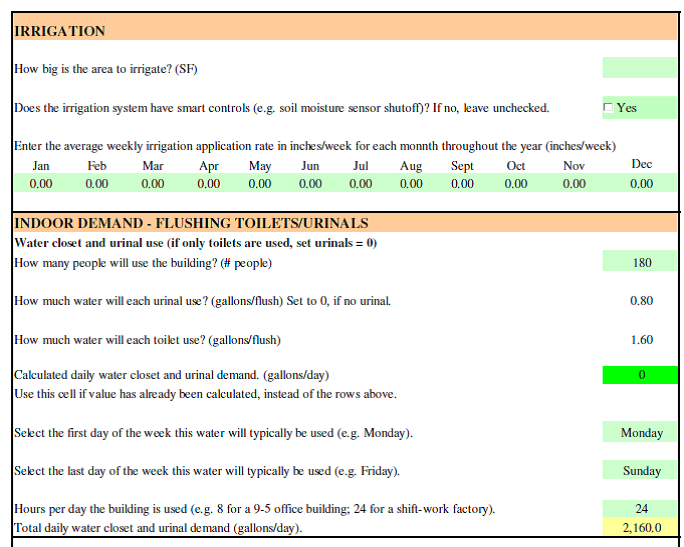
Range of Tank Sizes
The next (and most important) step is the iterative process used to find the proper tank size. Common tank sizes can range from 600 gallons to 50,000 gallons and larger. The cost of the tank and installation is usually the biggest piece of the rainwater budget. In most cases, the optimal tank size for a project will be reported as a range of sizes with potential use efficiency. For example, you may find from your spreadsheet calculations that your tank range is between 7,000 gallons and 18,000 gallons of storage. At 18,000 gallons you will maximize the water available for reuse and you will limit the number of events where you see an overflow of water, but you will also have the highest potential capital cost for the cistern. At 7,000 gallons you will have the lowest cost, but you will likely see more instances of makeup water usage and potential overflow during large storms. As with any engineering process, you need to determine your most important factor. Is it cost, efficiency, capture volume, reduction of makeup use, etc.? It is through this process that you will optimize the tank size to try and meet most of these needs. The typical efficiency of reusing water is typically between 70 – 80%. You could potentially get to 90%, but at a very high cost for a larger cistern. The image below shows the optimal tank size is probably 10,000 or 13,000 gallons.
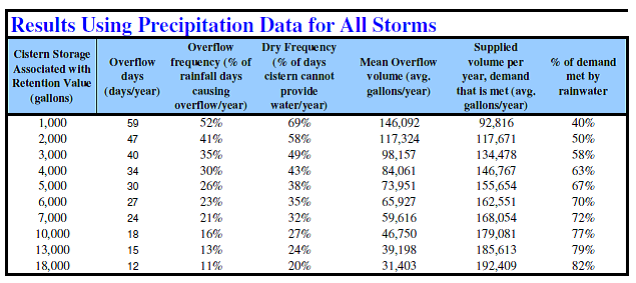
Another factor that must be considered is the local regulations and the minimum amount of storage that is needed to meet these standards. In many cases, multiple best management practices (BMP’s) may be used on a single project, so the cistern is only a portion of the required storage. If the cistern is the only BMP, it is easy to determine the minimum size of the cistern. This will be the regulated amount of storage required. If you see great efficiency, you may want to slightly increase the cistern size.
Summary
The considerations mentioned above are a realistic way to optimally utilize rainfall for reuse. If you follow these guidelines, you and your company can feel optimistic about your environmental footprint as well as your wallet. Rainwater collection is an ever-changing topic and there are various considerations in terms of sizing and properly maintaining your tanks, so let Tanks Direct assist you with every step of the process. Our dedicated team is here for you.